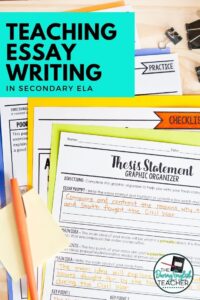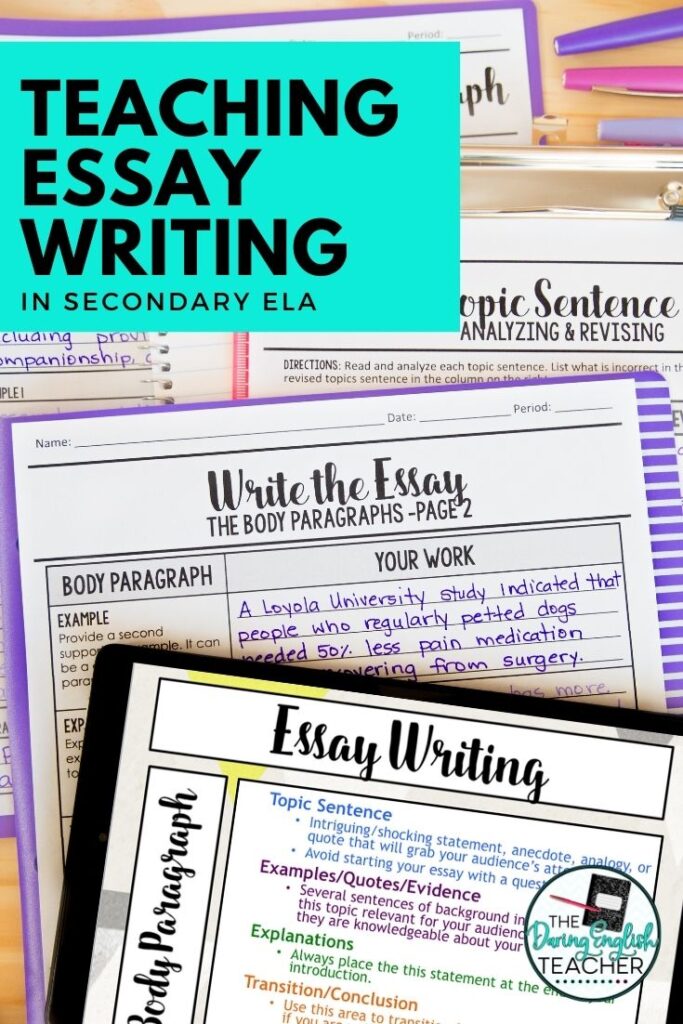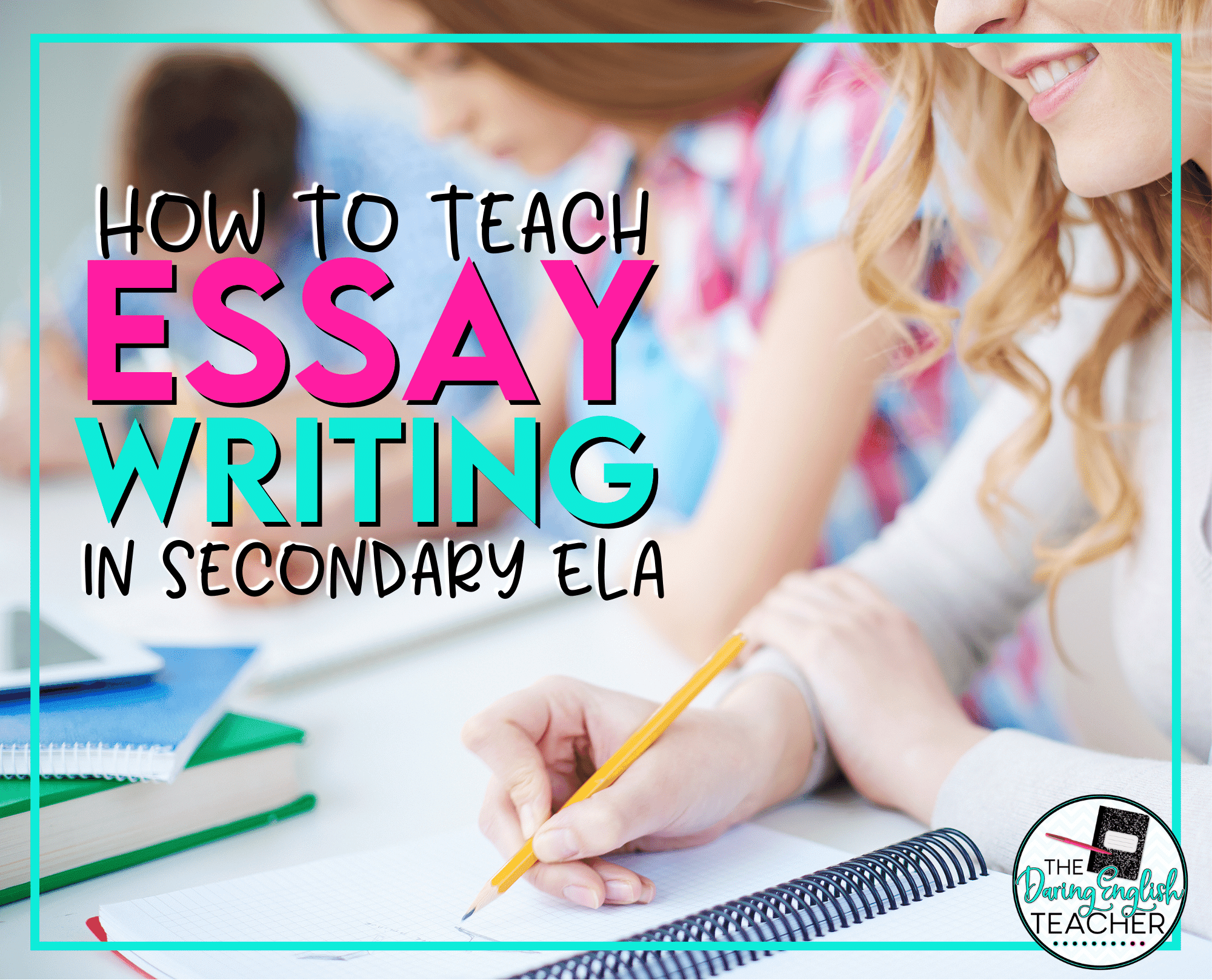Teaching students how to write a multi-paragraph essay is a process, and it isn’t something that can be taught in one class period, nor is it a skill that we should expect our incoming students to know. Before I even assign my students a multi-paragraph essay, I first take several weeks to teach paragraph writing, and I typically do this with my short story unit.
However, once my students are ready to make the jump from paragraphs to an essay, I still continue to break down my writing instruction. When I teach essay writing in my high school English students, I break it down paragraph-by-paragraph to encourage them to be the best writer they can be. All of the lessons that I will refer to throughout this blog post are included in this print and digital essay writing teaching unit.
Teach Essay Writing in Middle School and High School ELA
Start with brainstorming
I am a huge fan of group brainstorming, especially since I usually have some EL and SPED students mainstreamed in my college prep English classes. I usually dedicate an entire class period to brainstorming where students gather ideas, paragraph topics, and supporting quotes. You can read more about group brainstorming in this blog post where I discuss brainstorming with my students and I teach them how to brainstorm an essay.
Outline the essay
After brainstorming, I move my students to the outlining phase of the writing process. This step is essential because it helps students organize their papers and stay on topic. Ever since I started dedicating an entire class period to in-class essay outlining, I’ve noticed a significant improvement in my students’ essays. You can read more about how I teach essay outlining in this blog post. When we focus on outlining the essay, I make sure that we focus on all of the essential components of an essay: thesis statement, topic sentences, and evidence.
Write the thesis statement
After the class has completed the brainstorming and outlining, I then move on to direct instruction for essay writing. Since students have already outlined their main ideas, they can start working on their thesis statement. I use my introduction and thesis statement lesson to help students write a meaningful thesis statement. I also look at examples of good thesis statements with my students and have students turn in their draft thesis statements to me before moving on.

Write the introduction
Once students have a solid working thesis statement (and I say working because it is possible for it to change throughout this process), I then have them move on to the introduction. Using the same introduction and thesis writing lesson, I then have my students work on drafting a hook and background information to complete their introduction. Now that students are in high school, I don’t accept a question as an acceptable hook. However, if my students get stuck, especially some of my lower students, I have them write their questions and then help them turn them into a statement.
Also, I’ve noticed that students sometimes have a hard time jumping on the hook. They tend to get stuck there, and when this happens, I have them jump right into the background information. In doing so, students get started writing, and they can go back to the hook later.
Topic Sentences
When I complete essay outlining with my students before the drafting process, I typically have them outline each paragraph with a topic sentence and then the quotes they want to use. Once we move from the introduction to the body paragraphs, I have them work on their topic sentence first. I use my topic sentences and body paragraphs essay writing lesson with my students at this point in the essay. Once students have a good topic sentence for their body paragraph, they write the rest of their body paragraph.
Write the body paragraphs
The next step in the writing process, especially for the first essay of the school year, is for students to write out the rest of their body paragraphs. If they’ve done their outlining correctly, they have a good idea about what they want to include in their body paragraphs. In this step, I really emphasize that my students need to provide support and analysis. They should be providing more explanation than simply restating their quotes.
Write the conclusion
Once students have their introduction and body paragraphs complete, I then have them move on to writing the conclusion. At this step, I teach conclusion writing to my students and have them restate the thesis and add a general thought to the end of the paragraph. At this point, I emphasize that students should not be adding in any new information. Also, one way to help students rephrase their thesis statement is to have them rewrite it in two sentences since a thesis statement is typically a one-sentence statement.
Complete peer editing
 Once students are done writing, I like to engage them in a whole-class peer editing day where students look at multiple papers and also receive helpful feedback on their essays. In this blog post about peer editing, you can read more about how I conduct effective peer editing in the secondary ELA classroom.
Once students are done writing, I like to engage them in a whole-class peer editing day where students look at multiple papers and also receive helpful feedback on their essays. In this blog post about peer editing, you can read more about how I conduct effective peer editing in the secondary ELA classroom.
Provide time for essay revisions
Once students revise their essays and turn them in, I still like to provide students with some time to revise their essays after I grade them. This is where true learning and growth happen. It is when a student thinks they are done but then goes back to try to improve their essay. In this blog post about essay revisions, you can read more about how I conduct them in the classroom.
An entire year of writing instruction
What if I told you that you could have all of your writing instruction for the ENTIRE SCHOOL YEAR planned and ready to go? I’m talking about all the major writing strands and peer editing to grading rubrics. Just imagine how much time and stress you’ll save!
It almost sounds too good to be true, right?
It’s not! My Ultimate Writing Bundle is your one-stop shop for all of your writing instruction needs! Plus, your students will thrive with the built-in scaffolding and consistency throughout the year!


